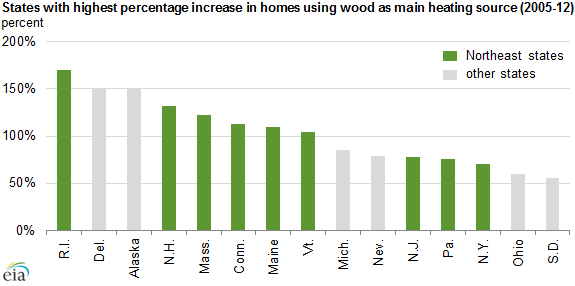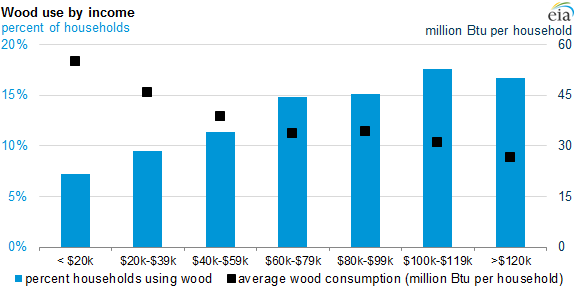Just as the Energy Information Administration (EIA) is telling us that more people are relying on wood for home heating, the President’s Environmental Protection Agency (EPA) is introducing new regulations to dampen its use. The Obama administration claims it wants to reduce carbon dioxide emissions and to support renewables, but it appears that the only renewable energy sources they actually support are wind and solar.
Unlike biomass (a fancy name for wood and other renewable materials), wind and solar cannot handle the needs of this country due to their intermittency, low capacity factors, and expense. It is clear that the Obama Administration wants to ratchet up the price of energy for everyone in this country and is attacking all the reliable fuel sources. After all, fire produces carbon dioxide.
Coal and Nukes under Attack
Coal and nuclear energy have been under attack by their respective regulatory agencies. The EPA has issued its Mercury and Air Toxics Standards (MATS) rule that has an estimated 60,000 megawatts of coal-fired plant retirements as its cost to the American economy. Another regulation limiting the amount of greenhouse gas emissions that new coal-fired plants can release ensures no new coal-fired plants will be built in the United States for the technology is not available to meet the standard, and the EPA actually admits they expect none to be built in their regulatory explanation Later this year, EPA is expected to respond to an order from President Obama to add a regulation that will limit greenhouse gas emissions from existing coal-fired plants. As President Obama said in 2008, “So if somebody wants to build a coal-powered plant, they can. It’s just that it will bankrupt them because they’re going to be charged a huge sum for all that greenhouse gas that’s being emitted.”
The Nuclear Regulatory Commission is delaying approvals of licenses to extend the life of nuclear reactors, throwing uncertainty into the future of some reactors, and adding to the expense of many of those remaining due to new safety regulations promulgated after the Fukushima accident. In January 2013, the United States had 104 nuclear reactors. That number is now 100 and others have been announced for decommissioning.
Now More Wood Regulations
The new EPA rules on wood would reduce the maximum airborne particulate emissions for new wood-burning stoves to 4.5 grams per hour initially, and after 5 years, further reduce the level to 1.3 grams, (an 80 percent reduction). It will add between $300 and $500 to the cost of a new stove to achieve the targets. Many people who burn wood to save money will not be able to afford this cost increase. According to Reg Kelly, founder of Earth Outdoor Furnaces, “There’s not a stove in the United States that can pass the test right now. This is the death knell of wood burning.”
The current rules on wood burning stoves were adopted in 1988 and those stoves have improved in efficiency and emissions by adding catalytic converters.
The new standards also affect newly manufactured adjustable-rate woodstoves, pellet stoves, wood-fired hydronic heaters, forced-air furnaces, masonry wood heaters, and a type of previously unregulated woodstove known as a “single burn-rate” stove.
The standards are currently in review with the public. The public comment period on the proposed standards ends on May 5.
These standards come on top of previously released EPA regulations where EPA reduced allowable particles in the air from 15 micrograms per cubic meter to 12 micrograms. To put this in perspective, a lighted cigarette in a closed automobile releases 3,000 to 4,000 micrograms of particulate matter per cubic meter. According to the Washington Times, “The rule isn’t about improving actual air quality, but about Washington asserting control over what sort of businesses can operate and what sort of products Americans can buy.”
Wood Consumption for Home Heating on the Upswing
About 2.5 million U.S. households (2.1 percent) consume wood as the main fuel for home heating, an increase from the 1.9 million households (1.7 percent) that used it as their main heating fuel in 2005. An additional 9 million households (7.7 percent) consume wood as a secondary heating fuel. The combined usage totals about 500 trillion Btus of wood consumption per year in the residential sector — about the same as propane consumption and slightly less than fuel oil consumption.
According to the EIA, wood consumption for home heating is on the upswing, and is “most notable in the Northeast.” Between 2005 and 2012, the nine states in the New England and the Middle Atlantic Census divisions saw a jump of at least 50 percent in the number of households that rely on wood as their main heating source. The increase came about with the decline in fuel oil and kerosene use due to the expense of these petroleum fuels.

Source: Energy Information Administration, http://www.eia.gov/todayinenergy/detail.cfm?id=15431&src=email
Heating stoves are the most common source of residential wood heating and fireplaces are the most common choice for secondary wood heating. While most households that consume wood as their primary fuel source burn split logs, the use of wood pellet stoves has risen in recent years. According to EIA, households in higher income brackets are more likely to consume wood, while those at lower income levels who burn wood consume more of it on average. (See chart below.)
Source: Energy Information Administration, http://www.eia.gov/todayinenergy/detail.cfm?id=15431&src=email
Conclusion
President Obama’s EPA is at it again—now with regulations on wood-burning stoves that have been regulated since 1988 and already using catalytic converters to reduce emissions. The new rules will require an 80 percent reduction in emissions over a 5 year period and will add $300 to $500 to the cost of a new wood-burning stove. Wood-burning stoves are the oldest heating method known to mankind and the mainstay of rural homes and many of the nation’s poorest residents. For the do-it-yourselfer and the increasing number of Americans entering the poverty roles, wood heat may be their only choice, and they will be forced to forego the EPA’s mandated expensive stoves for the EPA has not yet been able to outlaw fire. The agency’s stringent one-size-fits-all standards sadly apply equally to heavily air-polluted cities and far cleaner areas of Alaska and the U.S. West. So, we now find that not even wood is green enough or renewable enough for the Obama Administration.




